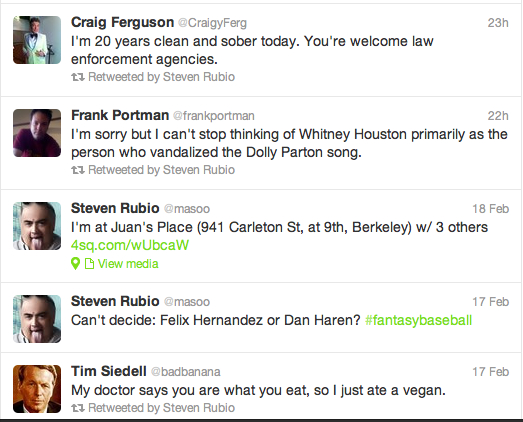Early this week, I found myself following a piece of breaking baseball news. The subject of the news isn’t what matters; you could substitute the debt-ceiling crisis, or impending revolt in a troubled country, or a terrorist act in Norway. I got a phone call from my son around 10:30 Wednesday morning, telling me that it appeared our favorite baseball team, the San Francisco Giants, was making a trade for a valuable player named Carlos Beltran. We only talked for a few minutes, after which I knew I had to track this story down.
When I was a kid in the 1960s, any breaking news less important than the death of a president was broken on the evening news. If, as in this case, it was baseball news, you might hear about it when that day’s game was on the radio. For anything more detailed, you had to wait until the next day, when the morning paper arrived.
Over the last month, I’ve developed a fond obsession for Google+, the search behemoth’s latest attempt at entering the online social realm. Google+ is an enticing and fascinating project, still in what Google is calling a “field trial,” that combines elements of email, Facebook, and Twitter, using lessons learned from their failed Wave and Buzz projects to improve the usefulness of users’ overall experience.
Wednesday, though, I went straight to Twitter. There I read lots of supposition from fans, driblets of actual news from reporters who knew only a little more than the fans, and lots of instant analysis of a move that hadn’t even been finalized yet. There were also rumors from anonymous sources; someone with a marginal connection to someone else in the Giants organization knew about Beltrán’s flight schedule. This kind of source needs to be checked and double-checked, but in the meantime, it sits there for us to peruse.
The availability of such information marks a major shift from the way news came to us in the past. An editor would track all updated material, assign different reporters to follow up on different sources, everyone would strive to do the necessary double-checking, and then and only then, the story would go to press.
With Twitter, we are all editors, getting the news as it happens. We are forced to do our own filtering, and the speed of the updates may create a situation where it is too easy to neglect the double-checking. One single person barely has time to keep up with the never-ending tweets, much less check the facts.
In the middle of all of this flood of not-yet-news, a tweet came through about a no-hitter that was happening at that very moment. A no-hitter, for non-fans of baseball, is an extremely rare event and a great personal accomplishment for the player who achieves it. So I turned on the MLB Network, a nationwide cable station run by Major League Baseball, and watched the historic ending to that game, all the while keeping an eye on Twitter.
By noontime, I had already posted to my blog about the imminent trade, summarizing events as they had occurred thus far. But I spent very little time on the baseball news itself. What interested me instead were the methods I used to keep myself updated, and the quickness with which those updates arrived.
Partly because Google+ is essentially in beta mode, with a smallish number of users, participants are made up largely of early adopters, many of them from the tech world. And, given the general interests of the techies and the relative absence of people with other things to talk about, a lot of the discussions on Google+ revolve, predictably, around Google+.
At this early stage, people are trying to define the project, and it is difficult to do this without using comparisons to existing areas like Facebook and Twitter. This is something of a misinterpretation of Google+. Google+ doesn’t just replicate or combine other services; in some ways, it is unique. And there are areas where it is unlikely Google+ will ever replace existing services. In the area of breaking news, for example, Twitter retains its advantage as a useful tool.
I’ve spent a lot of time the last month on Google+. Google+ would be a good place to hangout, a place where a bunch of us could have a group video chat about the news. Truthfully, even with the relatively small number of users in its initial days of operation, Google+ was already a good place to have a discussion about anything. But Twitter is where the news is breaking, not Google+.
As the day went on, some of the reporters posted brief blog updates on their newspapers’ sites, but the real action remained on Twitter, where the little bit of real information available was disseminated almost instantly, and where, as always, lots of people offered instant analysis that amounted to less than nothing.
By the end of the day, the trade was finalized. Carlos Beltrán joined the Giants for their game on Thursday. The morning newspapers had star columnists offering their take, which wasn’t necessarily more astute than the instant analysis of the tweeters, but which was at least better written (if nothing else, the columnists had more than 140 characters to make their point).
It’s hard to draw any conclusions from such brief moments, but it is clear that right now, Twitter is a valuable, popular tool for the near-instant acquisition of breaking news. It is not clear, right now, that Google+ will co-opt that ability in Twitter. And perhaps it won’t be necessary to try. Twitter, with its 140-character limit, is like Headline News, leaving Google+ for the analysis and discussion.
One more oddity: I haven’t mentioned Facebook. I have no idea why, but the structure and UI of Google+ seems more congenial to leisurely discussions than that of Facebook. Despite a much smaller user base, Google+ postings, to my eye, elicit far more substantial exchanges than do those on Facebook. Twitter is where people tell you that Amy Winehouse has died. Facebook is where people post Amy Winehouse videos and say “R.I.P.” And Google+ is where people discuss the implications of Amy Winehouse.
I wonder if the unspoken concept that makes these services different is “fun.” The pace of Twitter is exciting, and it is indeed fun to keep up with breaking news, all the while making your own (often incorrect) assumptions. A timely tweet with an appropriate hashtag makes us not just readers, but newsbreakers as well.
Facebook’s version of fun is, surprisingly, more frivolous than Twitter’s (surprising because the 140-character limit seems to invite frivolity.) This is not necessarily a bad thing; we participate in communities on Facebook that simply don’t exist on Twitter, and it’s “fun” to share with others, even when the news is bad.
Google+ has a nice UI; a lot of people, myself included, find it more fun to use in a technical sense than either of the other services. But with an imposed age limit of 18-and-over, and a much easier method for directing posts to a specified audience, Google+ thus far seems to invite what I can only call a more adult approach to online interaction. It is pointless to choose one service or another. Perhaps the lesson is that all are useful.
Postscript: Zack Wheeler is the promising young ballplayer the Giants traded away to get Carlos Beltrán. Before he left for his new team, Wheeler thanked the Giants fans, “who have been nothing but good to me.” He let us know this via Twitter. It was a nice tip of the cap to the fans, and a reminder that while we see breaking news from a distance, to the participants, it’s just what happens in their life.





